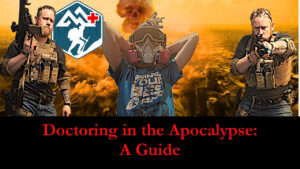Should Wounds Be Stitched in a Survival Situation?

Getting cut is just part of everyday life and in this modern age we live in, with all the enormous wealth and comfort we enjoy as Americans, it’s easy to take for granted the healthcare system we have in place to deal with such things.
Even life-threatening lacerations with severed major arteries are little more than an inconvenience these days, if timely and appropriate care is given. Standard procedure includes potent antibiotics to reduce the chance of infection, and expert wound repair to ensure a proper knitting together of tissue.
In the collapse of our modern society however, none of these luxuries will be available and the Apocalypse Doctor knows even a small cut could become a life and death scenario if not handled correctly.
My time in the military meant a detailed study and practice of suturing and it was something I enjoyed. In fact, I’d say stitching people back together is my favorite part of medicine. A Corpsman’s entire focus, from start to finish is wound care. Often Medics and Corpsman are there at the moment the wound is received and are responsible for controlling bleeding, and then providing follow up wound care to the casualties, often until healed.
The opportunity to see so many different types of wounds and how to deal with each has meant plenty of experience, and below I’ll try to pass on some of what I learned in case it’s helpful to you one day. But first I’ll address 2 of the most common questions I get:
Question #1 “When should you suture a wound closed in an emergency?”
The most efficient answer here is:
Never.
When working in the ER at 29 Palms I had an HA (E2) Cruze working for me. He was brand new to the Navy and brand new to my ER and when he was put on my shift it fell to me to teach him my favorite procedure, sewing people up. After a few shifts Cruze began to get the hang of it and started feeling more comfortable with the process of passing needle and thread through human flesh and pulling the ragged pieces back into alignment.
Then, one day when HA Cruze was off duty, a Marine came into the ER with a serious infection in his left forearm. On closer inspection I could see through the draining puss: long red hairs sticking up in goopy mess. Confused, I asked the Marine what the hairs were.
“Oh, I cut myself at a party about a week ago, and one of your Corpsman, Cruze was there, and he said he’d stitch me up. So, he got out my wife’s sewing kit, and sewed me up with a needle and thread.”
Because he’d used standard cloth thread, it quickly disintegrated into the long red hairs and caused it to fester. Overconfident in his new skills, Cruze hadn’t used proper wound care procedures, or the right suturing equipment and as a result, caused a very serious infection in the Marine which would have killed him if left uncared for.
The point of this story is: A little knowledge can be dangerous, for you and the people you are caring for. Don’t go stitching anyone up just cause you read this article. This should be left to professionals because it can be dangerous for a great many reasons.
Question # 2 “Ok, then what about those nifty butterfly bandages?”
Many medical kits include nifty wound closure devices intended to take the places of sutures in a survival situation where you want to close the wound. This can be extremely hazardous to your casualty’s health for reasons we’ll go into below.
If you don’t read any further, just know that if you use those butterfly bandages to close an injury, you’re at a substantially higher risk for infection.

Wound Care in Survival Situations
- Assessment: The first step in wound care is to assess the injury. Evaluate the wound's size, depth, and location, and determine whether it involves underlying structures like tendons or blood vessels. Repairing these will be beyond our ability because both will require the expertise of vascular and orthopedic surgeons.
- Control Bleeding: If life-threatening bleeding is happening, it must be controlled first. The Apocalypse Doctor is well versed in how to construct improvised equipment, like tourniquets and bandages.
- Cleanliness: Odds are good you’re not going to have a sterile operating room, it’s vital though, to cleanse the injury as thoroughly as possible. Copious amounts of clean water must be sprayed forcefully into it to flush away debris that would otherwise stay behind in the wound. If the it's closed up without flushing first, the debris will cause infection to begin.
- Dress and Protect: Cover the wound with a clean (or sterile when possible) dressing or improvised bandage to keep it free from contaminants.

Leave Open or Close?
- Infection Risk: Closing an open wound in a survival scenario carries a significant risk of infection. The wound is likely to contain dirt and harmful infection causing bacteria. Closing the wound traps these contaminants inside, increasing the risk of it becoming infected.
- Delayed Healing: If managed appropriately, it can begin to heal through the natural process of tissue regeneration. Closing the injury prematurely can interrupt this process, resulting in delayed healing and potential complications.
- Abscess Formation: If infection occurs within a closed wound, the body's immune response may lead to the formation of an abscess, a painful pocket of pus. Abscesses can be challenging to manage in an improvised setting, requiring drainage and potentially causing systemic toxic illness.
- Sepsis Risk: A severe infection stemming from a closed wound can lead to sepsis, a condition characterized by a systemic inflammatory response that. Sepsis can be difficult, if not impossible to treat without access to expert medical care, expensive equipment, and high-strength antibiotics.
- Dehiscence: Closing an injury with inadequate supplies or skills can result in poor wound closure (HA Cruze). This could lead to dehiscence, where the it reopens, increasing the risk of infection and requiring further intervention.
The Appropriate Time to Close a Wound
In survival situations, closing an injury is generally not recommended unless specific conditions are met. When considering closure, it is crucial to follow these principles:
- Clean and Sterile Environment: In a survival situation, it will be impossible to have a sterile environment to work in. the best you will be able to do is to have a clean space to operate. Use sterilized, purpose made instruments, clean dressings, and follow proper aseptic techniques, when possible.
- Inspection: Ensure that the wound is free from foreign bodies and debris. This requires a thorough examination to reduce the risk of infection. Be sure to flush the injury with copious amounts of fresh clean water.
- Appropriate Supplies: In survival settings, it can be challenging to access the necessary supplies for wound closure. If you have the proper supplies and the knowledge to close a wound safely, consider it. However, if you are uncertain, err on the side of leaving the wound open.
Docs Wrap Up
Wound care is a crucial aspect of Apocalypse Doctoring, and knowing the dangers associated with closing open wounds is at the top of the list.
In survival scenarios, it’s safer to leave an inury open to reduce the risk of infection, delayed healing, and complications. Proper assessment, cleanliness, and protection are strict rules for effective care in austere environments and long-term emergencies. Anyone who may find themselves in remote or challenging situations should make wound care knowledge a top priority and be prepared to make informed decisions regarding wound management for themselves and their team.
